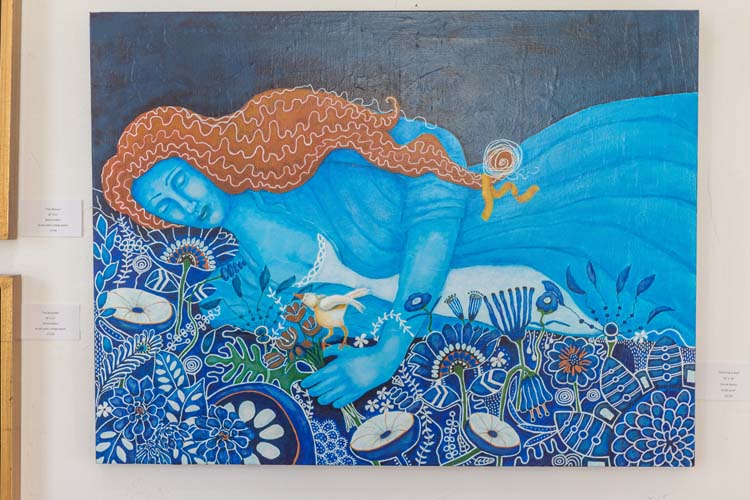
To the sensitive soul, the implied backstory of any one of the tiny characters in Bonnie Bolton’s paintings and assemblages serves as an irresistible magnet.
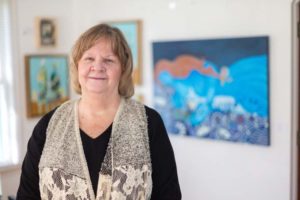
Bonnie Bolton
Always whimsical, and often tongue-in-cheek, Bolton’s works feature characters whose moody faces – often borrowed bits from ancient photos – suggest a triste longing for something beyond the confines of their shadow box prisons.
“I am constantly surprised at who is attracted to my work,” says Bolton, whose exhibition of paintings and works in collage and 3-D assemblage can be seen this month at Vero’s Center for Spiritual Care. Titled “Dream Chronicles & Other Tales,” the show’s artworks spring from Bolton’s abundant imagination, vivid dream life, and love of thrift store finds.
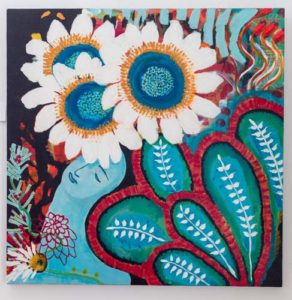
Dreaming of My Garden
Until a couple years ago Bolton sold her work in prominent art fairs around Florida. She quickly learned the temperament of her audience when a fairgoer – an average person, by casual observation – would spend a fair amount of time in her booth, carefully examining every detail of the artwork to which he or she had been inexorably drawn. Such admirers predictably became art owners before they left the booth.
“Some people get it and have a creative bent themselves maybe,” says Bolton. “And then there are those who just don’t get it at all.”
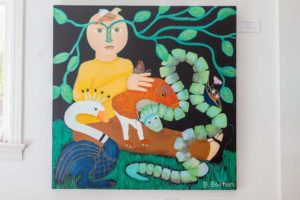
My Dreams Make No Apologies
The newest works in the show are a series of mixed-media paintings on canvas. The slightly older works are assemblages of found objects with collage displayed in shallow birch boxes. There are also a couple of free-standing assemblages; one is a floor lamp born of a dressmaker’s mannequin.
Bolton purchased the mannequin from a Melbourne thrift shop years ago; it wasn’t until recently that she was inspired to use it in an artwork. As found, the headless form had been covered by another artist’s hand with a collage of seed packets.
“She stood around in my studio for a long time because I didn’t know what to do with her,” Bolton says.
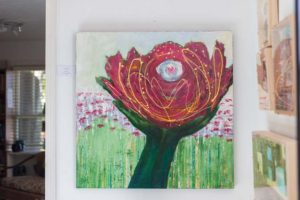
Each and Every
After removing the existing collage, Bolton began to paint the slender simulacrum. Encircling the hips of the figure she created a blue and green landscape, complete with a collaged-on nymph; the upper torso features decorative painting that suggests an Eden of stylized leaves and flowers. A vintage lampshade floats above the truncated neck. Bolton had someone else do the wiring for the lamp.
“I don’t know anything about electricity,” she says.
Bolton’s paintings also focus on the female figure. Her trio of collage paintings titled “Pearl,” “Ruby,” and “Opal” have as their subjects three “girls” whose faces – collaged-on Victorian portrait photos – are as decidedly old-fashioned as their names. As limned by Bolton, the figures’ bodies present humorous variations on human proportion. For instance, Ruby’s long right arm arcs over her head to terminate in a handbag near her left elbow.
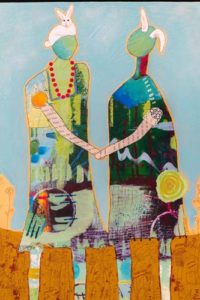
Bad Hair Day
In one of the assemblages, a neighborhood of closely set houses take on the proportions of a family by the addition of collaged-on portrait photos, one at the apex of each roof.
Bolton grew up in New Jersey, one of six siblings whose mother was the sole breadwinner and head of the house. The straitened circumstances in which they lived did not prevent her mother from playfully encouraging Bolton’s earliest art projects.
“She would save birthday cards and Christmas cards. I would turn them into books and draw on them. And she would help me make doll houses out of cardboard boxes,” Bolton says.
She also had paper dolls to play with.
“I was never satisfied with the clothes that were on them,” says Bolton, who would color over the togs until they met with her childish approval.
“The child in me is still here,” she says of her grown-up paper doll creations.
As a little girl Bolton was not a fan of baby dolls. Now though, as a fully-fledged artist, she is fascinated by the porcelain doll’s head she found in a junk shop a few years ago.
“The hair on the doll’s head is very chopped up, so I knew that some little girl had given her a short hairdo,” Bolton notes. “That made it all the more charming.”
In one of the assemblages on display at the Center for Spiritual Care, Bolton placed the head atop a plinth that serves as the doll’s body. On its “chest” is the tin-framed portrait of a woman whose eyes roll ecstatically upward; she could be a penitent saint or a silent film vamp. With a rosary hung about its waist and carved wings sprouting from its shoulders, the figure looks ecclesiastical.
“That probably comes from my Catholic background,” says Bolton.
She periodically uses religious symbolism or artifacts in her work in recognition of the beauty of Catholicism, the awe she felt in church, and the memory of her religious education.
“You know, the whole Catholic school experience,” she says with a knowing smile.
Religion is not the artist’s only inspiration. Of late, crime has entered the picture.
Although Bolton has lived in Vero Beach for the past 20 years, she raised her children Alan and Rob in West Palm Beach. Both still live in that area; Alan is a computer security expert with his own company, and Rob is the senior fingerprint examiner at the West Palm Beach Police Department. Familiar with his mother’s artistic M.O., it was Rob who gave her some defunct fingerprint and ID card files from a departmental housecleaning.
“They are from the 1920s, ’30s and ’40s. I have a whole stack. Some of them have really great photos on them,” Bolton says.
On view is a collage that pairs up a fingerprint set with an unrelated vintage photo of a grumpy-looking man. He wears an undershirt over which Bolton has pasted numbers to assign him the role of “prisoner.” Cleverly, the artist used part of the photo to cover the name of the person on the ID card beneath it.
“It may have been a very long time ago, but I don’t want to have somebody’s relative calling me up one day,” Bolton says.
While that is not likely, the number of winged and winsome female figures that grace the show are sure to elicit appreciative comments and, the artist hopes, sales.
The Center for Spiritual Care is located at 1550 24th Street in Vero Beach.



